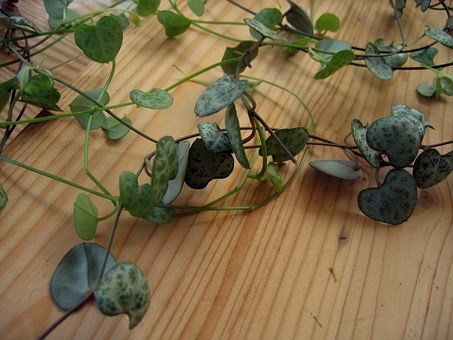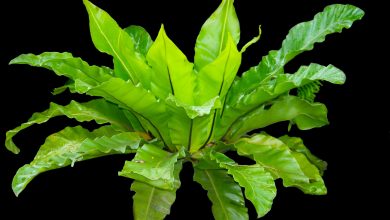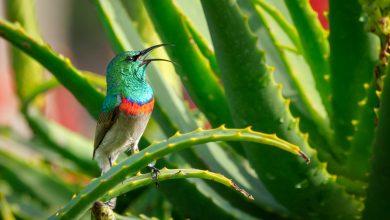String of Hearts Plant Care

Ceropegia woodii, otherwise known as string of hearts or rosary vine, is a member of the Apocynaceae family and is native to Southern Africa, particularly Zimbabwe, Swaziland, and South Africa.
The string of hearts plant is a succulent trailing vine. The plant grows up to four inches in height, with a spread reaching up to 13 feet. Its nickname refers to the thick heart-shaped evergreen leaves. The stems and the underside of the leaves are magenta colored.
Ceropegia woodii is a flowering plant. The flowers have vividly purple petals, with a white and pale magenta corolla. The roots of the plant, and less frequently the stems, develop small tubers. When they appear, stem tubers form at nodes, and this is why the plant is also referred to as rosary vine. In tropical areas where the plant can survive outdoors, Ceropegia woodii is a mildly invasive species.
Caring for String of Hearts Plants
C. woodii will grow outdoors only in tropical or subtropical climates but will do well indoors. As a result, the plant is a popular houseplant, often raised in hanging baskets and pots so that its trailing stems hang down to display the many silvery green, heart-shaped leaves. The rosary vine is a relatively easy plant to care for.
Temperature
The string of hearts plant prefers warm temperatures of 70 to 80 degrees Fahrenheit. As such, position the plant in warm areas of the house, away from windows and doors that may let in cold drafts. Ceropegia woodii will be at its best if temperatures do not fall below sixty degrees.
In the summer, you may take the plant outside, but ensure that it doesn’t sit outside until nightfall when temperatures drop below 60 degrees Fahrenheit.
Light
Don’t keep Ceropegia woodii in direct sun for extended periods, as direct rays burn the leaves. Light from a south-facing window is ideal, but a west or east-facing window will work if it permits enough light. As light is crucial for proper leaf development, allow the plant to get four to six hours of light daily.
You can tell when the plant is getting sufficient light by the color of the leaves; pale green leaves indicate adequate light. Large gaps between leaves and pale green leaves are signs of insufficient light. In the summer, when outdoor temperatures are warm enough to permit the rosary vine outside, place the plant in the shade to protect it from the sun.
Water
The rosary vine is technically not a succulent. Still, you should treat it as one, seeing as the thick leaves store water. Water the plant when the soil dries out from the last watering and then flood it until the water drains from the hole. Ensure that the plant does not stand in water for long.
Ceropegia woodii prefers dry conditions to wet soils; too much water will cause the plant to suffer root rot. In the winter months, the plant goes into dormancy and will require even less water. The rosary vine’s tolerance to dry conditions is one of the reasons for its popularity as a houseplant.
Soil
Plant the string of hearts in a quick draining and aerated soil, as the plant isn’t fond of overly moist soils. Mixes for cacti and succulents will work well. You can also add perlite or sand to regular potting soil to achieve the desired drainage.
An important point to consider when adding perlite to the soil is the humidity of the area. If you live in a humid region, ensure that the potting mix is coarse so that water drains off quickly.

Humidity
The Ceropegia woodii is a semi-succulent plant that doesn’t need much humidity to thrive. Average indoor humidity will suffice. The heart-shaped leaves can tell you if the plant requires moisture. Ideally, the leaves should be thick and deep green. If the leaves are dried, then you should increase humidity.
In drier climates, you can increase humidity by misting the plant in the morning or with a humidifier. You can also keep the plant in the bathroom for some time. Higher humidity won’t have any adverse effects, but in such cases, you may have to reduce how frequently you water the plant.
In winter, reduce watering, but step up the humidity, like climate control on chilly days will leach moisture from the air.
Flowering
Ceropegia woodii is famous for its uniquely shaped leaves and not its vase-like purple flowers. With sufficient light, flowers may appear at any time, but typically they appear in the summer and earlier parts of autumn. The flowers may last up to six weeks, after which the string of hearts will rest until springtime.
Fertilizer
Rosary vine doesn’t need frequent fertilizing. Once a month during the spring to midsummer summer months is ideal. Doing so will prevent root burn and fertilizer buildup in the soil.
Don’t feed the plant in the fall and winter when it goes into its dormant stage. Regular water-soluble or liquid-based fertilizer diluted to half strength will work for rosary vines.
Potting
The trailing vines and uniquely shaped flowers of Ceropegia woodii make them great decorative plants that you can hang outside or in a home garden. Ensure that the pot is not oversized, as the string of hearts prefers to have its roots packed together.
The right pot for the string of heart is one with holes in the bottom to allow water to drain out. Containers without holes in the bottom cancel out the infrequent watering and quick-draining soil, leading to root rot.
Re-Potting
Rosary vines do not require frequent re-potting, as their roots do not grow extensively. The plant also prefers tight spaces. Still, when re-potting is necessary, it’s best done in the spring, right before the start of new growth, so that the plant can better handle the strain. Poor drainage, arising from compacted soil, pests and diseases, and weak spring growth are reasons why you may re-pot a string of hearts plant. Follow the steps below to re-pot a rosary vine:
- Lay the old pot sideways, and carefully pull out the plant.
- Remove as much of the old soil as you can from the roots without damaging them. This point is a good time to separate the plants if you have too many growing in one pot.
- Place the plant in a new pot and cover the roots lightly with soil.
- Wait until the soil dries out before watering.

Propagation
The Ceropegia woodii is easy to propagate and with a high success rate. You can propagate the plant using cuttings or the small bead-like tubers that form along the stem.
The ideal way to propagate the rosary vine is with the tubers on the stem. The tubers appear after the plant blooms. Choose a suitable tuber, and position the vine such that the tuber rests on moist soil in a tray. When new leaves begin to grow, you can cut the tuber from the parent plant and re-pot. You can also detach the tubers from the stem and plant them like seeds. This technique is slightly less effective, however.
The second method of propagation is by cuttings. This method is suitable for plants that don’t yet have tubers growing along their stems. Simply cut off some vines and put the ends in damp soil to root. You can also put the cuttings in water and transfer them to a pot when the roots appear.
Propagate two to three tubers or cuttings in one pot to create a bush-like effect, as individual vines appear spindly and are significantly less attractive.
Pruning
In nature, rosary vines can grow up to 13 feet, but indoor rosary vines only grow to around three feet and often do not require pruning, except to keep trailing vines in check. Nevertheless, Ceropegia woodii is a robust and fast-growing plant and won’t object to aggressive pruning if need be. You can use the cuttings from pruning to propagate new plants.
Diseases and Pests
One of the reasons why the string of hearts is a low-maintenance plant is that it doesn’t suffer from many diseases or pests. Root rot is the most common issue with these plants and appears as yellowing and drooping leaves. Usually, if the leaves have turned yellow, then the rot is too extensive. It’s best to discard the plant, as it won’t recover.
You can easily avoid root rot with a quick-draining soil, watering infrequently, and using a container with holes in the bottom.
Aphids and mealybugs are the primary pests that trouble the string of hearts plant. Mealybugs are common houseplant pests appearing as a white cotton-like substance on the foliage and stems. These insects feed on plant juices and will kill the plant if left unchecked. Spraying the plants regularly with neem oil can dissuade mealybugs. Use a cotton swab dipped in alcohol to eliminate mealybugs.
Aphids are smaller than mealybugs. These insects feed on floral tissue in the plant. Regularly misting the top and underside of the rosary vine’s leaves with neem oil should keep aphids away. You can exterminate existing aphids with insecticidal soap.
Toxicity
Rosary vines are houseplants that are safe for pets. The California Poison Control System lists Ceropegia woodii as non-toxic to humans. Still, the bead-like tubers may pose a choking health hazard to children.



